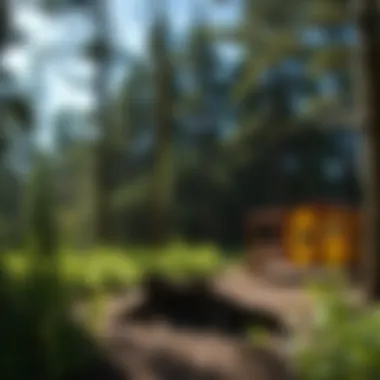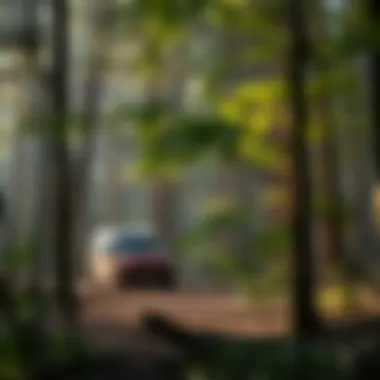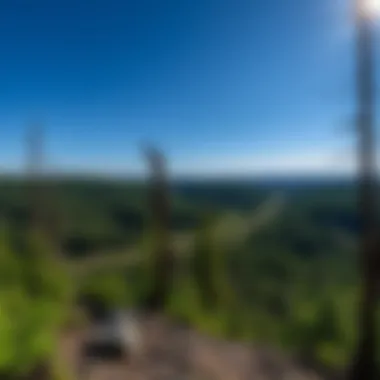Discovering Indiana State Park Campgrounds: A Complete Guide


Intro
Whether you're a seasoned camper or someone looking to dip your toes into the wild, Indiana's state park campgrounds are a great escape from the humdrum of daily life. These spots, spread across lush landscapes, offer a variety of options catering to different preferences—be it a no-frills tent stacking under the stars or the comfort of a cabin with all the amenities. This guide will take you through the nooks and crannies of these campgrounds, highlighting their unique features, amenities, and activities that make them stand out.
But it’s not just about setting up camp. It's essential to understand how these beautiful natural areas have been crafted through sustainable methods and mindful practices. As the camping community grows, recognizing our responsibility toward the environment becomes paramount. Let’s dive in and see what makes Indiana state park campgrounds a hotspot for outdoor enthusiasts and a haven for conservationists alike.
Overview of Indiana State Parks
Indiana's State Parks are more than just picturesque landscapes; they are a realm of natural wonder and historical significance. Within these parks lies a tapestry woven with threads of history, ecology, and community values, all coming together to offer unique opportunities for recreation and relaxation. Understanding the importance of these parks is essential as it not only enriches the experience for visitors but also emphasizes the role of preservation and conservation in our shared environment.
History and Significance
The establishment of Indiana's State Parks dates back to the early 20th century when an increasing awareness of natural conservation began to take root across America. As cities expanded and industrialization surged, vast stretches of land risked becoming lost to development. The state's response was discerning; it recognized the necessity of preserving natural spaces for public use and enjoyment. This foresight laid the groundwork for a legacy that would span generations.
Beyond their recreational appeal, these parks serve as critical habitats for countless species of flora and fauna. They act as living museums, embodying a rich tapestry of Indiana's history, from Native American heritage to early pioneers. Each trail, lake, and campground reflects a piece of the state’s ecological and cultural story, making it imperative for visitors to engage with and appreciate these historical narratives.
Diversity of Ecosystems
Indiana’s State Parks are a chassis that supports a rich diversity of ecosystems; this includes various environments like forests, wetlands, and grasslands. Each ecosystem offers distinct attractions and has its unique ways of contributing to the health of our planet.
Forested Areas
The forested areas of Indiana State Parks serve as a sanctuary for wildlife and a refuge for people. These densely wooded regions enhance biodiversity and serve as a critical carbon sink. The lush greenery of oak, maple, and pine creates vibrant habitats that draw visitors for camping and hiking. A specific aspect that stands out is the changing foliage in autumn; it becomes a vibrant canvas of colors that beckons leaf-peepers from near and far. Moreover, the whispers of the wind through the leaves offer a sense of tranquility not easily found in urban settings.
Wetlands
Wetlands in Indiana's State Parks are often underrated jewels. They act as natural filtration systems, improving water quality and providing crucial habitats for a plethora of species, including amphibians, birds, and fish. The key characteristic of wetlands is their role in controlling flooding by absorbing excess rainwater. However, the often-muddy terrain can deter some visitors. This unique feature makes exploring these areas both challenging and rewarding, providing a glimpse into the complex balance of nature at work.
Grasslands
Contrarily, grasslands present a different but equally vital ecosystem within Indiana’s parks. These open spaces support unique plant communities and attract numerous pollinators, which are essential for plant reproduction. The expansive fields offer an inviting atmosphere for families interested in activities such as picnicking or kite flying. The downside is that grasslands may feel less appealing in harsher weather, but during pleasant spring and summer days, they open up opportunities for exploration and connection with nature.
Legal Framework and Conservation Efforts
The intricate legal framework governing Indiana State Parks emphasizes the commitment to conservation and sustainable practices. These laws not only protect the natural beauty of the park but also serve as guidelines for responsible use. Conservation efforts are bolstered by community involvement and educational initiatives that aim to instill a sense of stewardship in all visitors. This integrated approach fosters a culture of respect and care that is essential for maintaining the integrity of these vital ecosystems for generations to come.
In summary, understanding the overview of Indiana State Parks invites both seasoned adventurers and newcomers into a deeper engagement with the natural world. By appreciating the history, diversity of ecosystems, and legal frameworks, visitors can embrace a more responsible and fulfilling experience while exploring the campgrounds that Indiana has to offer.
Types of Campgrounds in Indiana State Parks
Indiana State Parks offer a tapestry of camping experiences, each suited to different demographics and preferences. Understanding the types of campgrounds available is vital for both seasoned campers and newcomers alike. Each campground caters to unique needs, allowing groups, families, and individuals to forge unforgettable connections with nature. Additionally, knowing the specific features and benefits of each campground type can enhance the overall camping experience. With a variety to choose from, there’s bound to be a perfect fit for everyone.
Primitive Campgrounds
Primitive campgrounds present an opportunity for the more adventurous spirit. They are intentionally basic, offering little more than a patch of ground, a fire ring, and sometimes an outdoor toilet. Here, the emphasis lies on immersing oneself in the beauty of Indiana’s natural landscapes without the distractions of modern conveniences.
Location Benefits
The location benefits of primitive campgrounds are monumental for those seeking solitude. Nestled away from the more tourist-heavy areas, they often boast serene surroundings. This isolation allows campers to truly absorb the sights and sounds of nature.
One key characteristic that sets these sites apart is their accessibility to hiking trails and natural features; secluded lakes, lush forests, and quiet streams become your neighbor. Choosing a primitive site encourages a deeper connection with the environment, as one must adapt and learn to respect their surroundings. However, this lack of facilities means campers should be well-prepared.
Target Audience
When discussing the target audience for primitive campgrounds, it’s clear that these sites attract a diverse group. Outdoor enthusiasts, experienced campers, and those looking to escape reality usually flock to these locales. It's a popular choice for individuals who appreciate simplicity and the rugged charm of nature.
A unique feature that draws this audience is the opportunity for self-sufficiency; there’s no electricity or running water here, and that’s precisely what some crave. However, it may not be the best fit for families with small children or those unaccustomed to camping, as the lack of amenities can pose challenges.
Family Campgrounds
Family campgrounds, on the other hand, cater to a different set of needs. Designed to accommodate families wanting to bond over outdoor activities, these sites strike a balance between nature and comfort. They come equipped with more amenities than primitive options, allowing families to enjoy the outdoors without sacrificing convenience.
Amenities Offered
The amenities offered in family campgrounds often include picnic tables, fire pits, and even modern restrooms. These features make the camping experience easier for families with children. A key characteristic is the availability of safe spaces for kids to play while parents relax nearby.
This accessibility is a large part of what makes family campgrounds a hit; parents don’t have to worry as much about their children wandering too far in search of fun. However, while these sites typically provide comfort, some camper purists argue that they detract from the authentic camping experience.
Family-Friendly Activities
Examining family-friendly activities, these campgrounds offer a cornucopia of options designed to keep everyone entertained. From organized games and arts and crafts to nature hikes and fishing opportunities, families can participate in various activities that promote bonding and learning.
One of the key characteristics here is the variety; while both parents and kids can engage in these activities together, there are also opportunities for children to make friends, allowing parents to enjoy some much-needed relaxation time. Plus, engaging in such activities can foster a respect for nature in younger generations. That said, families should be aware that larger crowds may lead to busier areas and less privacy compared to more secluded campgrounds.
Group Campgrounds
For those planning a larger gathering, group campgrounds serve as a perfect setting. These sites are tailored for larger parties where friends or family can camp together. Group campgrounds provide a communal experience, ideal for reunions, retreats, or any gathering that centers around outdoor fun.


Reservation Policies
Examining reservation policies, group campgrounds typically require advance booking, and regulations might differ from standard sites. This aspect ensures everyone has allocated space. A key characteristic here is the opportunity for camaraderie, as knowing you'll be joining a group creates excitement and anticipation. However, flexibility may be limited, as larger groups often have to fit into fixed spots based on availability.
Recreational Facilities
When looking at recreational facilities, group campgrounds usually have access to amenities designed for larger parties. These can include grill areas, shared fire pits, and sometimes even pavilions for gatherings. A highlight of group campgrounds is the communal area where stories and laughter can circulate freely by the warm glow of a campfire.
However, potential downsides include noise levels if multiple groups are present, along with the difficulty in securing a reservation during peak season. For those seeking solitude, these sites may not provide the quiet retreat one longs for in the great outdoors.
In summary, Indiana State Parks offer various campgrounds tailored to different audiences. Primitive sites cater to the rugged camper, family campgrounds provide comfort and engagement, and group campgrounds encourage togetherness. Each type reflects the diversity and richness of outdoor experiences available in these treasured state parks.
Amenities and Services Available
When considering a camping experience, the amenities and services available at Indiana State Park campgrounds can either make or break your trip. They provide not just comfort but also enhance the overall outdoor experience. Understanding what each campground offers can help campers plan better, ensuring that all their needs are met amidst the natural backdrop of Indiana's beautiful parks. Let’s take a detailed look at each aspect of these facilities.
Basic Facilities
Restrooms
Restrooms at Indiana State Parks are more than just basic facilities; they’re lifelines to comfort while you immerse yourself in nature. Most campgrounds boast clean and maintained restrooms which often include running water and hand sanitizer. A key characteristic of these restrooms is accessibility. This is vital for families, older adults, or anyone needing quick access.
These restrooms represent a practical choice, allowing campers to refresh without straying far from their tent or camper. A unique feature of many restrooms in these parks is the use of eco-friendly products and water-saving fixtures, aligning with sustainability goals. Of course, it's worth noting that during peak seasons, lines may form, which can be a minor inconvenience for those eager to get back to their adventures.
Water Access
Water access is an essential aspect for campers, especially in the wild. The availability of potable water throughout the campgrounds ensures that visitors stay hydrated and can cook meals or wash up as needed. A notable aspect of this water access is that it usually comes from reliable sources, often treated and tested for safety. This makes it a popular choice and critically important for family trips where children are involved.
However, while most campgrounds offer water spigots scattered throughout, some remote sites may have limited access, which necessitates planning around water needs. Campers must often fill their containers before heading to more secluded areas where such amenities aren't as common.
Advanced Amenities
Electric Hookups
Electric hookups provide a modern advantage to many campers wishing to maintain some level of comfort while enjoying the outdoors. These hookups allow for the use of small electronic devices, lights, and even air conditioning in RVs and trailers. This attribute is especially appealing to families and older campers who prefer a chilled drink and lighting after dusk.
The unique feature here is the convenience of having electric access, which indeed enhances the camping experience but, on the flip side, may draw you away from the authentic essence of a rugged adventure. Nonetheless, these hookups are well-situated around various campgrounds, offering a seamless blend of nature and convenience.
Showers
Showers at Indiana State Parks mean the difference between a simple wash and a refreshing experience in nature. Supplied with warm water, these showers provide an opportunity to wash off the dust and sweat after a day of hiking or fishing. The key characteristic of these showers is that they often include private stalls, which is a significant advantage for families or individuals who value privacy.
While the presence of showers is generally welcomed, a common concern is their availability during peak seasons; frequently, they'll experience heavy traffic. Additionally, some campers may need to pack their shower gear, including biodegradable soaps, to adhere to the parks' sustainable practices. These facilities, while they provide comfort, often remind campers of the importance of being responsible in nature.
Pet-Friendly Options
For campers who prioritize their pets, many Indiana State Parks provide pet-friendly campgrounds. Campers can bring their furry companions along, ensuring that no one is left behind while exploring the great outdoors. These areas typically offer designated trails, pet waste stations, and even dog-friendly cabins.
A standout feature of pet-friendly campgrounds is the sense of community they foster among campers, exchanging tips and sharing stories while dogs romp around together. However, pet restrictions apply, like leash requirements and limitations on certain areas, so it’s essential to familiarize oneself with specific campground rules. Through these options, visitors can appreciate nature with their pets, enhancing the overall camping experience while remaining considerate of fellow campers and wildlife alike.
Whatever your needs may be, understanding the array of amenities and services available can significantly enhance your camping trip experience in Indiana State Parks.
Planning a Camping Trip
Planning a camping trip is not just a fun endeavor; it’s a crucial part of ensuring a rewarding experience at Indiana State Park campgrounds. Preparing adequately can make the difference between a trip that’s a hit or a total flop. Ever gone camping only to realize you forgot the marshmallows or the sleeping bags? It’s those little details that can turn a good weekend into a hassle.
When considering a trip to these natural retreats, it’s important to look at various elements that are pivotal to your experience. From picking the right campground to understanding weather patterns and local regulations, all these factors play into what kind of camping adventure you’ll have. The more you prepare, the smoother things tend to run.
Choosing a Campground
Choosing the right campground sets the stage for your whole trip. Not all campgrounds are created equal, and understanding what each offers can greatly enhance your stay.
Factors to Consider
When evaluating various campgrounds, a few key factors stand front and center. First, location is essential. Some campgrounds are nestled deep in the woods, offering seclusion, while others are conveniently located near popular attractions. Think about your group’s preferences. Do you want to truly escape into nature, or are you looking for a mix of nature and accessibility?
Another aspect is the amenities provided. Some campgrounds offer just the basics—restrooms and fire pits—while others boast clean shower facilities and electrical hookups. This can be especially crucial for families or people thinking about bringing their pets.
Also, take the time to check reviews from fellow campers. They can provide insights on cleanliness, staff helpfulness, and overall atmosphere. For instance, campgrounds that see heavy use often have detailed reviews that can offer a glimpse of what to expect.
Seasonal Availability
Understanding seasonal availability is fundamental to avoid any surprises. Not every campground is open year-round. Many parks close down during winter months or have certain sections that are inaccessible due to weather conditions.
The timing of your trip can also dictate the type of experience you’ll have. Traveling in peak season usually means more families and crowds, but it also means more programmed activities and amenities. On the flip side, camping during the shoulder seasons can mean quieter hikes and more opportunities to connect with wildlife.
Additionally, some parks often schedule maintenance for the off-seasons, which could affect your choice. Keeping a calendar handy that tracks park openings can be a game-changer.


Making Reservations
Once you've figured out the campground, it's time to make reservations. This is not a step to underestimate; securing your spot can save you a lot of headaches.
Online Platforms
Today, many state parks offer online booking platforms. This method is a convenient choice for those who like to take care of details with a few clicks. The user-friendly interfaces allow you to see available dates and adjust your plans accordingly.
Moreover, online reservations often provide more up-to-date information, including any changes in park policies or facility updates. However, one should be cautious of the internet’s pitfalls — always ensure that you're booking from the official park website to avoid scams. Also, beware of processing fees that some platforms might add in.
Phone Reservations
Though digital solutions are handy, there remains a charm in talking to someone directly. Whether you're having questions about specific sites or need help deciphering campground layouts, phone reservations can offer a personalized touch.
One benefit is the immediate feedback you can receive, clearing up any uncertainties right away. However, it’s worth noting that high call volumes can sometimes mean long wait times, especially during busy seasons. If patience isn't your strong suit, calling at less busy hours can be more rewarding.
Packing Essentials
After you've made your reservations, it’s time to think about what you'll need to take with you. Packing smart can mean the difference between a comfortable trip and one filled with annoyances.
Basic Gear
First off, your basic gear is what sets up your outdoor haven. A robust tent, sleeping bags according to the season, and a reliable cooler will go a long way in ensuring comfort. Don’t forget the cooking equipment as well; camping stoves, pots, and utensils should not be left at home.
Every bit of this gear plays its part in making the adventure enjoyable and hassle-free. Ensure that your tent is easy to set up—some brands offer models that can go up in just a few minutes. Less time wrestling with poles and more time enjoying the campfire is the aim here.
Safety Equipment
Safety equipment should also be at the forefront of your packing list. A first aid kit, flashlights with fresh batteries, and a multi-tool can prove invaluable. It’s better to have it and not need it than to need it and not have it.
In addition, keep emergency numbers handy and have a way to access them, even if you're going off the grid. Should something unfortunate happen, being prepared can make a world of difference.
Ultimately, each of these facets of planning a camping trip ensures that you're poised for a memorable experience in Indiana's stunning nature. With thoughtful preparation, you can savor every moment, from the rustle of leaves in the wind to the crackle of a campfire under the stars.
Activities at Indiana State Park Campgrounds
When you think of Indiana State Park campgrounds, it's easy to just picture the serene backdrop of nature, but let’s not overlook the activities that turn those wilderness getaways into unforgettable adventures. Engaging with these activities enables campers to connect with the environment, promote healthy habits, and enjoy the great outdoors to its fullest potential. From exploring various trails to fishing and wildlife observation, each activity offers a unique experience that resonates with both casual campers and seasoned outdoor enthusiasts.
Hiking Trails
Trail Ratings
Trail ratings are of prime importance when embarking on a hiking adventure. They serve as indicators of a trail's difficulty, guiding hikers to choose paths that match their fitness levels and experience. Typically categorized as easy, moderate, or difficult, this system helps ensure safety and enjoyment. For instance, a family with young children might appreciate an easy trail with flat terrain, while seasoned hikers could crave the challenge that steep inclines offer.
What's more, these ratings are often supplemented by detailed descriptions. Trail ratings consider factors like elevation gain, footing conditions, and overall length. These thorough assessments can help a hiker select a route that meets both their skill level and their desire for scenic beauty, ultimately enhancing their outdoor experience. However, a drawback of these systems is that they can sometimes be subjective depending on who rates them; what's easy for one might be moderate for another. Therefore, individuals are encouraged to consider their own capabilities and maybe even read a few reviews before setting out.
Scenic Routes
Scenic routes are where the Indiana State Parks truly shine. These trails are not only about reaching a destination but also about discovering remarkable views along the way. What's particularly enticing about these paths is their design; they often snake through picturesque landscapes, offering glimpses of serene lakes, towering trees, and vibrant wildlife. They are a capture of nature's painted canvas, displaying seasonal changes that can be breathtakingly beautiful.
One of the unique features of scenic routes is the opportunity to engage with nature through multi-sensory experiences—sights, sounds, and smells intermingle to create memorable hikes. However, it’s essential to remain mindful while enjoying these routes, as popular scenic trails can become crowded, detracting from the tranquility one might seek in the wilderness. Planning an early start or visiting during less busy times can vastly improve the experience.
Fishing Opportunities
Popular Lakes
Indiana's State Parks are rangy with lakes that appeal to fishing enthusiasts of all levels. Some notable lakes, like those in Brown County State Park, provide ample opportunities for catching species such as bass, catfish, and bluegill. These lakes not only offer the thrill of the catch but also serve as peaceful retreats where one can unwind, listen to the gently lapping water, and watch the sun set.
These lakes are strategically located near campgrounds, which means after a night of restful sleep, you can be casting a line in no time. Another highlight is that many of these lakes have well-maintained fishing piers, making it easier for all ages and skill levels to participate in this pastime. However, avid fishers should consider potential fishing regulations and specific licenses that might be needed.
Regulations
Regulations for fishing in state parks are crucial for maintaining ecological balance and ensuring sustainable practices. These rules can include seasonal restrictions, size and quantity limits on fish, and designated fishing zones, all aimed at preserving fish populations and the overall health of aquatic ecosystems.
Understanding these regulations is not merely a nuisance; it's a commitment to protecting natural resources for future visitors. A key benefit is that these regulations help safeguard habitats, contributing to a more enduring fishing environment. However, adhering to them requires that anglers remain informed, as changes may occur year to year, and the lack of awareness can lead to unintentional violations.
Wildlife Observation
Common Species
Wildlife observation is another enticing activity in Indiana State Parks. The diversity of ecosystems supports a range of species, from deer to myriad bird species. Campers can enjoy spotting these animals in their natural habitats, enhancing the camping experience with a touch of excitement and wonder. Birdwatching, in particular, can attract enthusiasts who wish to catch a glimpse of migratory birds or local varieties, making for an educational excursion as well.
The unique feature of abundant species in these parks is what makes them a premier destination for wildlife enthusiasts. However, one must practice patience and stealth during observation. While sightings can be exhilarating, they often require early mornings or quiet evenings, and even then, it can depend on luck. Therefore, understanding peak times and behavior patterns of these species can enrich the experience significantly.
Guided Tours
For those interested in getting up close and personal with nature, guided tours offer engaging opportunities that enrich the understanding of the local ecosystem. These tours can provide insights about the flora and fauna that may go unnoticed by the untrained eye. Professional guides are often knowledgeable and can share interesting facts that enhance the educational aspect of wildlife observation.


The benefit of guided tours lies in their capacity to offer structured learning experiences, which may be particularly appealing for families or groups. Furthermore, well-organized tours can lead to safer wildlife observation experiences as guides are trained to handle encounters with wildlife appropriately. However, it's essential to note that group tours may limit personal flexibility. Participating individuals need to consider their level of interest and comfort with group dynamics before signing up.
Sustainability Practices in Camping
Sustainability is more than just a buzzword in today’s outdoor realm; it’s a commitment to protecting the very landscapes that enhance our camping experiences. In the context of Indiana State Park campgrounds, engaging in sustainable practices is essential not only for the preservation of these natural resources but also for ensuring that future generations can enjoy the great outdoors as we do today. This section will provide a closer look at specific sustainability practices, their benefits, and considerations for the conscientious camper.
Leave No Trace Principles
The foundations of responsible camping are often encapsulated in the Leave No Trace principles. These seven guidelines serve not merely as suggestions but as an ethical framework for engaging with our environment. They encompass everything from proper waste disposal to minimal impact campsite selection. Understanding and implementing these principles can preserve Indiana's scenic beauty.
- Plan Ahead and Prepare: Knowing where you're going, what to bring, and how to conduct yourself can reduce the chance of human error.
- Travel and Camp on Durable Surfaces: Sticking to established trails and camping spots limits damage to vegetation and soil integrity.
- Dispose of Waste Properly: Carry out what you carry in. This includes using appropriate systems for human waste, trash, and food scraps.
- Leave What You Find: Enjoy the natural surroundings without removing any rocks, plants, or historic artifacts.
- Minimize Campfire Impact: If fires are allowed, use established fire rings, keep them small, and ensure they are completely extinguished before leaving.
- Respect Wildlife: Observe animals from a distance, avoid feeding them, and keep a safe space to allow them to move freely.
- Be Considerate of Other Visitors: Engaging with fellow campers courteously fosters a shared sense of respect and enjoyment within the park.
By adhering to these principles, campers contribute to the longevity and health of the park's ecosystems, enhancing everyone’s experience.
Geology and Soil Conservation
The geological makeup of Indiana’s state parks is not just a backdrop; it's a complex tableau that tells the story of our planet. Protecting soil and geological formations is crucial, as they play a pivotal role in supporting ecosystems. Soil holds moisture, provides nutrients, and serves as a habitat for numerous organisms.
Perhaps one might think of soil as nature's sponge, absorbing rainwater and minimizing runoff. This not only sustains plant life but also prevents erosion, which could lead to the loss of habitat and adversely affect water quality.
Campers can play a crucial role in soil conservation by:
- Camping on established sites to prevent soil compaction.
- Avoiding the creation of new trails, which can lead to severe erosion.
- Using biodegradable soaps to minimize chemical runoff into waterways.
Community Involvement in Conservation
It’s often said that “it takes a village,” and this rings especially true for conservation efforts in Indiana's parks. Local community involvement is paramount to sustaining and improving these natural landscapes. Volunteers often engage in park clean-up events, invasive species removal, and educational programs that inform the public about local ecosystems.
Moreover, partnerships between community organizations and state parks foster a sense of stewardship and investment in local resources. Individuals can contribute in various ways:
- Participating in local conservation projects.
- Advocating for sustainable practices within their circles of influence.
- Supporting policies and initiatives aimed at protecting local ecosystems.
Ultimately, the more we engage with our community and take active steps in conservation, the deeper our appreciation for these natural wonders will grow.
“The best time to plant a tree was twenty years ago. The second best time is now.” This wisdom rings particularly true in the context of conservation, reminding us that every small action can lead to significant impact.
Traveling Responsibly in State Parks
Traveling responsibly in state parks is not just a good idea; it's essential for the preservation of these natural habitats. When we venture into the wilds of Indiana, it's our duty to leave it better than we found it. The philosophy here is simple but profound: every choice we make can either contribute to or detract from the wellbeing of our ecosystems. By honoring this principle, campers play a crucial role in maintaining the health and beauty of Indiana's state parks for generations to come.
Wildlife Safety Guidelines
When you’re roaming around the forests and meadows, it’s important to remember that these spaces are not just for us; they’re home to a variety of creatures. To ensure safety for both visitors and wildlife, follow these guidelines:
- Observe from a Distance: It might be tempting to approach a deer or a cute raccoon, but getting too close can be dangerous for both parties.
- Secure Food and Trash: Animals are curious and have a keen sense of smell. Store food in bear-resistant containers if available, and ensure that trash is disposed of properly to avoid attracting wildlife.
- Follow Signage: Parks often have specific paths or viewing areas for wildlife observation—stick to these to minimize impact on the animals and their habitats.
"Treat the land and its inhabitants with respect and care—what’s a photo op compared to wildlife itself?"
Fire Safety Regulations
Fire enhances camping experience, but it can also wreak havoc on nature if not managed properly. Each campground has specific fire regulations, and it’s crucial to adhere to them for safety and conservation:
- Check Restrictions: Before lighting a fire, check if campfire bans are in place, especially during dry seasons. Certain areas may prohibit fires altogether.
- Use Designated Fire Pits: If permitted, always use established fire rings or pits to contain flames and reduce the risk of wildfires.
- Extinguish Completely: Douse your fire with water and stir the ashes until everything is cool to the touch. This helps reduce the risk of flare-ups and ensures that your site remains safe for future campers.
Environmental Impact Awareness
Being aware of our environmental footprint is vital as we explore Indiana’s parks. Each decision we make can have long-lasting effects on the flora and fauna that inhabit these areas. Here are a few key considerations:
- Leave No Trace Principles: Familiarize yourself with these principles, which emphasize minimizing your impact on the natural world.
- Stick to Trails: Straying from designated paths can cause soil erosion and damage plant life. Stick to marked trails to help preserve these ecosystems.
- Educate Others: Share knowledge about the importance of caring for the environment with fellow campers to inspire a collective movement toward responsibility.
Ending: Appreciating Indiana’s Natural Heritage
The Role of Camping in Conservation
Camping is not just a leisure activity; it plays a vital role in the conservation of Indiana’s precious ecosystems. By venturing into these natural spaces, campers cultivate a personal connection to the land, fostering respect and care for the environment. This relationship helps promote the idea of conservation, encouraging individuals to reduce their environmental footprint when enjoying the beauty that nature offers.
When campers observe wildlife or hike through diverse landscapes, they become advocates for the ecosystems they experience. Many states, including Indiana, provide educational programs and resources aimed at highlighting the importance of conservation efforts in state parks. These initiatives empower visitors to recognize their impact on the environment and to participate in advocacy for local conservation projects.
In many cases, camping fees contribute directly to park management and conservation funding. Therefore, every camping trip serves a dual purpose: enjoying the great outdoors while supporting initiatives that preserve it for future generations. By practicing sustainable camping habits—such as adhering to the Leave No Trace principles—campers can ensure they leave these natural treasures intact for others to enjoy.
Future Directions for Indiana State Parks
Looking ahead, the future of Indiana State Parks is one intertwined with sustainability and accessibility. With increasing pressures from climate change and urban development, parks are adapting their strategies to cope with these challenges.
Efforts underway include:
- Enhanced Conservation Programs: Developing programs that not only protect the flora and fauna but also rehabilitate areas that have suffered from neglect or overuse. This could involve replanting native species and restoring habitats.
- Environmental Education Initiatives: Creating more comprehensive educational programs for visitors that cover essential topics such as ecological stewardship and the significance of biodiversity.
- Inclusive Access: Indiana State Parks are exploring ways to improve access for all individuals, including those with disabilities. Building accessible trails and providing equipment rentals can open the doors to a wider audience, promoting a diverse camping culture.
- Sustainable Infrastructure: Upgrading facilities with environmentally-friendly practices, such as solar energy and water conservation systems, will not only enhance visitor experience but also reduce the parks’ ecological footprints.
As Indiana continues to place value on its natural heritage, these vital developments signal a promising direction toward a future where nature and humankind can coexist harmoniously. Embracing conservation and responsible recreation will be crucial components in ensuring that Indiana’s natural spaces flourish for generations to come.
"Parks are not just places to visit; they are living entities that require our attention and care."
In concluding, embracing and appreciating Indiana’s natural heritage through camping activities not only enriches lives but also strengthens our commitment to preserve these invaluable landscapes. The future of Indiana State Parks relies on us, the visitors, to be stewards of the land, ensuring that its beauty remains intact for all to enjoy.







